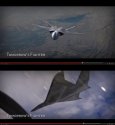TerraN_EmpirE
Tyrant King
moving on but using the same list. the Air force's Next Generation Tactical Aircraft program aims differently but will likely share a lot.
1. Spectrum dominance
not as much needed but in the modern era all fighters are multirole. Attacking targets on the ground and in the Air is likely to remain a need. but primarily the NGTA will be a Fighter.
2. Advance propulsion
again range. the F22A has a combat range of 400NMs with Base reductions, Expeditionary missions may force the USAF to extend it's ranges and push for higher supercruise velocities
3. Autonomous sensor and payload integration
also a need but the Air force would have more flexibility in weight and stealth options this will likely include all aspect stealth and advanced counter detection technologies.
The Air Force program and the Navy Program competitors that have thus far stepped up are Lockheed Martin, Boeing, and Northrop Grumman. Thus far we have seen two official Concepts Lookheed's

and Boeings.

There is also this graphic from Northrup Grumman nearly a decade old
.
All three As they stand show designs that have a very compact physical cross section with either a Flattened or nonexistent Tail and low profile. Therefore a naturally stealthy shape.
1. Spectrum dominance
not as much needed but in the modern era all fighters are multirole. Attacking targets on the ground and in the Air is likely to remain a need. but primarily the NGTA will be a Fighter.
2. Advance propulsion
again range. the F22A has a combat range of 400NMs with Base reductions, Expeditionary missions may force the USAF to extend it's ranges and push for higher supercruise velocities
3. Autonomous sensor and payload integration
also a need but the Air force would have more flexibility in weight and stealth options this will likely include all aspect stealth and advanced counter detection technologies.
The Air Force program and the Navy Program competitors that have thus far stepped up are Lockheed Martin, Boeing, and Northrop Grumman. Thus far we have seen two official Concepts Lookheed's

and Boeings.

There is also this graphic from Northrup Grumman nearly a decade old
.

All three As they stand show designs that have a very compact physical cross section with either a Flattened or nonexistent Tail and low profile. Therefore a naturally stealthy shape.
